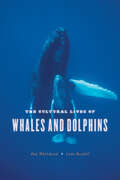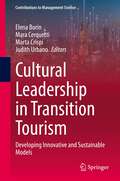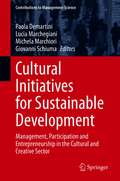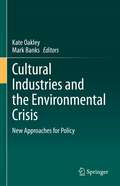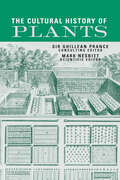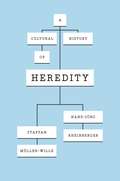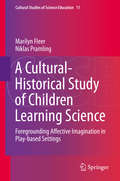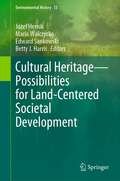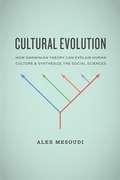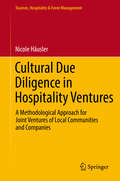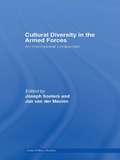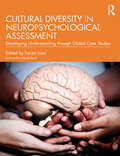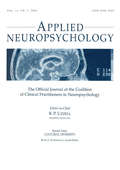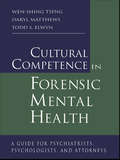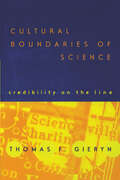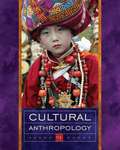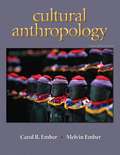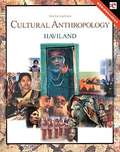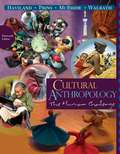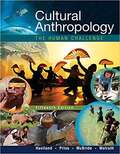- Table View
- List View
Cultural Materialism: The Struggle for a Science of Culture
by Marvin HarrisFirst published in 1968, Harris's book has been cited in over 1,000 works and is one of the key documents explaining cultural materialism, the theory associated with Harris's work. This updated edition includes the complete 1968 text plus a new introduction by the author, which discusses the impact of the book and highlights some of the major trends in anthropological theory since its original publication. RAT, as it is affectionately known to three decades of graduate students, comprehensively traces the history of anthropology and anthropological theory, culminating in a strong argument for the use of a scientific, behaviorally-based, ethic approach to the understanding of human culture known as cultural materialism
The Cultural Lives of Whales and Dolphins
by Hal Whitehead Luke RendellIn the songs and bubble feeding of humpback whales; in young killer whales learning to knock a seal from an ice floe in the same way their mother does; and in the use of sea sponges by the dolphins of Shark Bay, Australia, to protect their beaks while foraging for fish, we find clear examples of the transmission of information among cetaceans. Just as human cultures pass on languages and turns of phrase, tastes in food (and in how it is acquired), and modes of dress, could whales and dolphins have developed a culture of their very own? Unequivocally: yes. In The Cultural Lives of Whales and Dolphins, cetacean biologists Hal Whitehead, who has spent much of his life on the ocean trying to understand whales, and Luke Rendell, whose research focuses on the evolution of social learning, open an astounding porthole onto the fascinating culture beneath the waves. As Whitehead and Rendell show, cetacean culture and its transmission are shaped by a blend of adaptations, innate sociality, and the unique environment in which whales and dolphins live: a watery world in which a hundred-and-fifty-ton blue whale can move with utter grace, and where the vertical expanse is as vital, and almost as vast, as the horizontal. Drawing on their own research as well as a scientific literature as immense as the sea--including evolutionary biology, animal behavior, ecology, anthropology, psychology, and neuroscience--Whitehead and Rendell dive into realms both humbling and enlightening as they seek to define what cetacean culture is, why it exists, and what it means for the future of whales and dolphins. And, ultimately, what it means for our future, as well.
Cultural Leadership in Transition Tourism: Developing Innovative and Sustainable Models (Contributions to Management Science)
by Elena Borin Mara Cerquetti Marta Crispí Judith UrbanoCultural tourism has proved to be a significant source of economic development for cultural destinations, but it has also emerged as a sometimes potentially controversial and unsustainable phenomenon. The recent pandemic has also pointed out that we need different models of development of tourism, that include a more balanced approach to cultural components in cities and rural areas. Calls have been made on the need to design more sustainable models of tourism development for cultural destinations, conceiving tourism as a means to increasing the quality of life and generating economic opportunities in cities and regions by involving their communities and stakeholders. This book presents an in-depth analysis of the transition towards more sustainable models of cultural tourism development. Starting from the ongoing debate on cultural ecosystems, the book explores the potential key role of cultural and creative organizations as leaders of change. Including theoretical contributions, quantitative and qualitative analyses and international case studies, the book explores the role of cultural actors as leaders and their potential as drivers of culture-led innovation for tourism in cities and regions.
Cultural Initiatives for Sustainable Development: Management, Participation and Entrepreneurship in the Cultural and Creative Sector (Contributions to Management Science)
by Giovanni Schiuma Lucia Marchegiani Paola Demartini Michela MarchioriThis book explores the relevance of new sources, dimensions, and characteristics of knowledge for supporting creative and cultural organizations and initiatives.Special emphasis is placed on cultural heritage, participatory approaches, and entrepreneurship in the cultural and creative sector. The role of cultural heritage and contemporary culture as a source of economically effective, socially sustainable development is also discussed. The authors examine new ways of developing and testing new and innovative models of management for cultural heritage assets. In line with the participatory approaches in culture heritage governance promoted by the EU, the authors analyze participatory approaches to cultural and creative initiatives. The role of public and private actors, as well as the way they interact with each other in order to achieve collective outcomes, is of particular interest in this section of the book. With regard to cultural and creative entrepreneurship, the book adds an innovative view of cultural ventures, offering some clues from an entrepreneurial ecosystem perspective.
Cultural Industries and the Environmental Crisis: New Approaches for Policy
by Kate Oakley Mark BanksThis volume critiques the current model of the creative economy, and considers alternative models that may point to greener, cleaner, more sustainable and socially just cultural and creative industries. Aimed at the nexus of cultural and environmental concerns, the book assesses the ways in which arts and cultural activities can help develop ideas of the ‘good life’ beyond excessive and unsustainable material consumption, and explores the complex interactions between cultural prosperity, place and the quality (and availability) of employment, leisure and the rights to self-expression. Adopting a deliberately wide and inclusive interdisciplinary and international perspective, contributors to this volume showcase current and future ways of ‘doing’ creative economy, ecologically, otherwise and differently. In 11 chapters, the book outlines some of the most relevant arguments from among the growing literature that critically analyzes the current creative economy, with a focus on issues of gentrification, inequality and environment. This volume is timely, as it emerges into a political and economic context that is seeking desperately to ‘reboot’ the economy, re-establish ‘business as usual’ and to do so partly through significant investment and expansion in the creative economy. The book will be suitable for upper level undergraduates and postgraduates studying a wide range of topics, including: cultural and creative industries, media and communications, cultural studies, cultural policy, human geography, environmental humanities and environmental policy, and will be of further interest to arts professionals, creative economy researchers and policymakers. The chapter “Towards a New Paradigm of the Creative City or the Same Devil in Disguise? Culture-led Urban (Re)development and Sustainability” is available open access under a Creative Commons Attribution 4.0 International License via link.springer.com.
The Cultural History of Plants
by Mark Nesbitt Ghillean PranceThis valuable reference will be useful for both scholars and general readers. It is both botanical and cultural, describing the role of plant in social life, regional customs, the arts, natural and covers all aspects of plant cultivation and migration and covers all aspects of plant cultivation and migration. The text includes an explanation of plant names and a list of general references on the history of useful plants.
A Cultural History of Heredity
by Staffan Muller-Wille Hans-Jorg RheinbergerIt was only around 1800 that heredity began to enter debates among physicians, breeders, and naturalists. Soon thereafter it evolved into one of the most fundamental concepts of biology. Here Staffan Müller-Wille and Hans-Jörg Rheinberger offer a succinct cultural history of the scientific concept of heredity. They outline the dramatic changes the idea has undergone since the early modern period and describe the political and technological developments that brought about these changes. Müller-Wille and Rheinberger begin with an account of premodern theories of generation, showing that these were concerned with the procreation of individuals rather than with hereditary transmission. The authors reveal that when hereditarian thinking first emerged, it did so in a variety of cultural domains, such as politics and law, medicine, natural history, breeding, and anthropology. Müller-Wille and Rheinberger then track theories of heredity from the late nineteenth century—when leading biologists considered it in light of growing societal concerns with race and eugenics—through the rise of classical and molecular genetics in the twentieth century, to today, as researchers apply sophisticated information technologies to understand heredity. What readers come to see from this exquisite history is why it took such a long time for heredity to become a prominent concept in the life sciences and why it gained such overwhelming importance in those sciences and the broader culture over the last two centuries.
A Cultural History of Heredity
by Staffan Müller-Wille Hans-Jörg Rheinberger&“Thought-provoking…any scientist interested in genetics will find this an enlightening look at the history of this field.&”—Quarterly Review of Biology It was only around 1800 that heredity began to enter debates among physicians, breeders, and naturalists. Soon thereafter, it evolved into one of the most fundamental concepts of biology. Here, Staffan Muller-Wille and Hans-Jorg Rheinberger offer a succinct cultural history of the scientific concept of heredity. They outline the dramatic changes the idea has undergone since the early modern period and describe the political and technological developments that brought about these changes. They begin with an account of premodern theories of generation, showing that these were concerned with the procreation of individuals rather than with hereditary transmission, and reveal that when hereditarian thinking first emerged, it did so in a variety of cultural domains, such as politics and law, medicine, natural history, breeding, and anthropology. The authors then track theories of heredity from the late nineteenth century—when leading biologists considered it in light of growing societal concerns with race and eugenics—through the rise of classical and molecular genetics in the twentieth century, to today, as researchers apply sophisticated information technologies to understand heredity. What we come to see from this exquisite history is why it took such a long time for heredity to become a prominent concept in the life sciences, and why it gained such overwhelming importance in those sciences and the broader culture over the last two centuries.
A Cultural-Historical Study of Children Learning Science: Foregrounding Affective Imagination in Play-based Settings (Cultural Studies of Science Education #11)
by Marilyn Fleer Niklas PramlingThis book moves beyond the traditional constructivist and social-constructivist view of learning and development in science. It draws upon cultural-historical theory in order to theorise early childhood science education in relation to our currently globalised education contexts. The book argues that concept development in science for young children can be better theorised by using Vygotsky's concept of Imagination and creativity, Vygotsky's theory of play, and his work on higher mental functions, particularly the concept of inter and intrapsychological functioning. Key concepts are extracted from the theoretical section of the book and used as categories for analysis in presenting evidence and new ideas in the second section of the book. In this second part of the book, the authors examine how science knowledge has been constructed within particular countries around the globe, where empirical research in early childhood science education has occurred. The third part of the book examines the nature of the encounter between the teacher and the child during science learning and teaching. In the final part of the book the authors look closely at the range of models and approaches to the teaching of early childhood science that have been made available to early childhood teachers to guide their planning and teaching. They conclude the book with a theoretical discussion of the cultural-historical foundation for early childhood science education, followed by a model of teaching scientific concepts to young children in play-based settings, including homes and community contexts.
Cultural Heritage—Possibilities for Land-Centered Societal Development (Environmental History #13)
by Józef Hernik Maria Walczycka Edward Sankowski Betty J. HarrisThis book includes multi-national research studies (social and natural science research, as well as more directly practical university-based knowledge) about cultural heritage, land, and societal development in varied countries. The book is particularly about land use (as a fundamental aspect of the environment) and its role in development (especially sustainable development). Many of the studies are about topics concerning the transition from more rural to more urbanized land areas. However, some studies concern other types of changes. This includes general attention to globalization and nation-state dimensions of change. Nonetheless, there are interpretations communicated of unique histories at differing scales in the researches here. There is often a focus on more uniquely local and regional territories (including attention to smaller-scale land use) and an interest in future possibilities that conserve positive features of past terrain.
Cultural Geography (3rd Edition)
by Michael D. MatthewsCultural Geography contains many aspects of geography that will make one more aware of their connection to geography and how it influences them, their actions, and their interactions with others. Christian textbook.
Cultural Evolution: How Darwinian Theory Can Explain Human Culture And Synthesize The Social Sciences
by Alex MesoudiCharles Darwin changed the course of scientific thinking by showing how evolution accounts for the stunning diversity and biological complexity of life on earth. Recently, there has also been increased interest in the social sciences in how Darwinian theory can explain human culture. Covering a wide range of topics, including fads, public policy, the spread of religion, and herd behavior in markets, Alex Mesoudi shows that human culture is itself an evolutionary process that exhibits the key Darwinian mechanisms of variation, competition, and inheritance. This cross-disciplinary volume focuses on the ways cultural phenomena can be studied scientifically-from theoretical modeling to lab experiments, archaeological fieldwork to ethnographic studies-and shows how apparently disparate methods can complement one another to the mutual benefit of the various social science disciplines. Along the way, the book reveals how new insights arise from looking at culture from an evolutionary angle. Cultural Evolutionprovides a thought-provoking argument that Darwinian evolutionary theory can both unify different branches of inquiry and enhance understanding of human behavior.
Cultural Due Diligence in Hospitality Ventures
by Nicole HäuslerThis book introduces readers to a powerful method for cross-cultural due diligence in mergers and organizational collaborations. It employs the context of joint ventures between local communities and companies in the domain of hospitality in emerging tourism destinations. The book first analyzes the impact of cultural diversity in mergers between local communities and the private sector, revealing the characteristics and functions of culture and paying specific attention to the roles of organizational and community cultures in hospitality. In two subsequent methodological chapters the book presents a theoretical framework for cultural due diligence and identifies the principal actors, technical aspects and core principles. On the basis of a separate case study from northern Thailand, the book provides an example of cultural context analysis and presents the findings and results. In a concluding chapter the book presents an outlook on further research and development in this field.
Cultural Diversity in the Armed Forces: An International Comparison (Cass Military Studies)
by Joseph Soeters Jan van der MeulenThis volume explores ethnicity and gender developments in relation to the military. In some countries, the armed forces have a long history in responding to ethnic diversity, while elsewhere it has come up only recently as a policy issue. An even-handed representation of ethnic minorities in the military is recognized as crucial for enhancing its social legitimacy and professional quality. The same can be said about the integration of women in the military, which during a few decades across the board has grown into more than just another issue of personnel policies. Indeed with regard to gender, the symbolism and sensitivities surrounding core identities are at stake – as with the presence of gays and lesbians in the military. Written by experts in the field, the chapters cover fourteen countries around the world: the USA, Canada, Bolivia, Ecuador, Brazil, South-Africa, Eritrea, India, Israel, Great Britain, France, Germany, Belgium and The Netherlands. Taken together, the armed forces of these countries offer a fascinating mix of similarities and differences in the ways they try to manage cultural diversity. Cultural Diversity in the Armed Forces will be of interest to students and scholars of military studies, sociology, gender and political science.
Cultural Diversity in Neuropsychological Assessment: Developing Understanding through Global Case Studies
by Farzin IraniCultural Diversity in Neuropsychological Assessment provides a platform for clinical neuropsychologists, psychologists, and trainees to bridge cultures and speak to each other about the ethnically diverse communities they serve throughout the world. It allows readers to peek into their clinical filing cabinets and examine how they worked with diverse individuals from indigenous and migrant communities of Arab, Asian, European, Israeli, Latin American and Caribbean, Persian, Russian, Sub-Saharan African, and North American origin. The book first reviews important foundations for working with diverse communities that include key knowledge, awareness, skills, and action orientation. It then provides a collection of cases for each cultural geographic region. Each section begins with an introductory chapter to provide a bird’s eye view of the historical and current state of clinical and research practice of neuropsychology in that region. Then, each chapter focuses on a specific community by providing surface and deep-level cultural background knowledge from the authors’ unique perspectives. A case study is then covered in depth to practically showcase an evaluation with someone from that community. This is followed by a summary of key strategic points, lessons learned, references, further readings, and a glossary of culture specific terminology used throughout the chapter. In the end, the appendix provides a list of culturally relevant tests and norms for some communities. This ground-breaking peer-reviewed handbook provides an invaluable clinical resource for neuropsychologists, psychologists, and trainees. It increases self-reflection about multicultural awareness and knowledge, highlights practical ways to increase cultural understanding in neuropsychological and psychological assessments, and sparks further discussion for professional and personal growth in this area.
Cultural Diversity: A Special Issue of applied Neuropsychology
by B. P. UzzellCultural Diversity studies the relationship between culture and neuropsychology. Its goal is to examine salient aspects of this relationship and assist in bringing the issue of culture and cultural diversity to the forefront of neuropsychological discussions. The articles help further the understanding that ethnic and cultural variables are important not only in research design but also in clinical practice. In addition they urge clinicians to make cultural variables an integral component of any neuropsychological assessment and examine clinical data in the context of the patient's ethnic and cultural backround.
Cultural Competence in Forensic Mental Health: A Guide for Psychiatrists, Psychologists, and Attorneys
by Wen-Shing Tseng Daryl Matthews Todd S. ElwynAs culturally relevant psychiatry becomes common practice, the need for competent and culturally relevant forensic psychiatry comes to the forefront. This volume, written by one expert in cultural psychiatry and another in forensic psychiatry addresses that need. By combining their expertise in these areas, they are able to develop and create a new body of knowledge and experiences addressing the issue of the cultural aspects of forensic psychiatry. Beginning with an introduction to cultural and ethnic aspects of forensic psychiatry, this volume will address basic issues of the practice, as well as more detailed areas ranging from the various psychiatric disorders to intensive analysis and discussion of how to perform forensic psychiatric practice in a culturally relevant and competent way. Also the book suggests methods for continued awareness and sensitivity to issues of cultural and ethnic diversity in the field.
Cultural Boundaries of Science: Credibility on the Line
by Thomas F. GierynWhy is science so credible? Usual answers center on scientists' objective methods or their powerful instruments. In his new book, Thomas Gieryn argues that a better explanation for the cultural authority of science lies downstream, when scientific claims leave laboratories and enter courtrooms, boardrooms, and living rooms. On such occasions, we use "maps" to decide who to believe—cultural maps demarcating "science" from pseudoscience, ideology, faith, or nonsense. Gieryn looks at episodes of boundary-work: Was phrenology good science? How about cold fusion? Is social science really scientific? Is organic farming? After centuries of disputes like these, Gieryn finds no stable criteria that absolutely distinguish science from non-science. Science remains a pliable cultural space, flexibly reshaped to claim credibility for some beliefs while denying it to others. In a timely epilogue, Gieryn finds this same controversy at the heart of the raging "science wars."
Cultural Boundaries of Science: Credibility on the Line
by Thomas F. GierynWhy is science so credible? Usual answers center on scientists' objective methods or their powerful instruments. In his new book, Thomas Gieryn argues that a better explanation for the cultural authority of science lies downstream, when scientific claims leave laboratories and enter courtrooms, boardrooms, and living rooms. On such occasions, we use "maps" to decide who to believe—cultural maps demarcating "science" from pseudoscience, ideology, faith, or nonsense. Gieryn looks at episodes of boundary-work: Was phrenology good science? How about cold fusion? Is social science really scientific? Is organic farming? After centuries of disputes like these, Gieryn finds no stable criteria that absolutely distinguish science from non-science. Science remains a pliable cultural space, flexibly reshaped to claim credibility for some beliefs while denying it to others. In a timely epilogue, Gieryn finds this same controversy at the heart of the raging "science wars."
Cultural Boundaries of Science: Credibility on the Line
by Thomas F. GierynWhy is science so credible? Usual answers center on scientists' objective methods or their powerful instruments. In his new book, Thomas Gieryn argues that a better explanation for the cultural authority of science lies downstream, when scientific claims leave laboratories and enter courtrooms, boardrooms, and living rooms. On such occasions, we use "maps" to decide who to believe—cultural maps demarcating "science" from pseudoscience, ideology, faith, or nonsense. Gieryn looks at episodes of boundary-work: Was phrenology good science? How about cold fusion? Is social science really scientific? Is organic farming? After centuries of disputes like these, Gieryn finds no stable criteria that absolutely distinguish science from non-science. Science remains a pliable cultural space, flexibly reshaped to claim credibility for some beliefs while denying it to others. In a timely epilogue, Gieryn finds this same controversy at the heart of the raging "science wars."
Cultural Anthropology (9th edition)
by Serena Nanda Richard L. WarmsThis book continues to bring you excellent coverage of cultures from around the world. The text also continues to emphasize issues of gender, stratification, ethnicity, globalization, and contemporary issues.
Cultural Anthropology
by Carol R. Ember Melvin R. EmberCultural Anthropology,provides both a comprehensive and scientific introduction to cultural anthropology. It helps the reader understand how humans vary culturally and why they got to be that way. This new edition also highlights migration and immigration in the context of globalization.
Cultural Anthropology
by William A. HavilandCultural Anthropology is designed for introductory anthropology courses at the college level.
Cultural Anthropology: The Human Challenge
by William A. Haviland Harald E. L. Prins Bunny McbrideExplore the most fascinating, creative, dangerous, and complex species alive today: you and your neighbors in the global village. With compelling photos, engaging examples, and select studies by anthropologists in far-flung places, the authors of CULTURAL ANTHROPOLOGY: THE HUMAN CHALLENGE provide a holistic view of anthropology to help you make sense of today's world. With this text you will discover the different ways humans face the challenge of existence, the connection between biology and culture in the shaping of human beliefs and behavior, and the impact of globalization on peoples and cultures around the world.
Cultural Anthropology: The Human Challenge (Mindtap Course List Series)
by William A. Haviland Harald E. L. Prins WalrathExplore the most fascinating, creative, dangerous, and complex species alive today: you and your neighbors in the global village. With compelling photos, engaging examples, and select studies by anthropologists in far-flung places, the authors of CULTURAL ANTHROPOLOGY: THE HUMAN CHALLENGE, 15th Edition, provide a holistic view of anthropology to help you make sense of today's world. <p><p> With this text, you will discover the different ways humans face the challenge of existence, the connection between biology and culture in the shaping of human beliefs and behavior, and the impact of globalization on peoples and cultures around the world. It comes with MindTap, a digital interactive learning platform with an array of tools and apps from video clips to notetaking and flashcards, which will enliven your study and help you achieve better grades.

